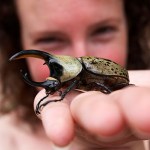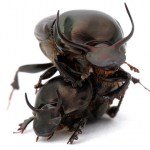Beetles
Opisthius richardsoni, Montana.
Opisthius richardsoni is a broad, flat ground beetle common along river banks in the colder regions of western North America.
photo details: Canon MP-E 65mm 1-5x macro lens on a Canon EOS 20D
ISO 100, 1/250 sec, f13, flash diffused through tracing paper
A Podabrus soldier beetle hides away in the leafy folds of an understory plant in an eastern deciduous forest. Soldier beetles (family Cantharidae) are predators of other arthropods.
photo details: Canon MP-E 65mm 1-5x macro lens on a Canon EOS 50D
ISO 100, 1/250 sec, f13, flash diffused through tracing paper
Looking like a trilobite, or perhaps a mutant millipede, a heavily armored beetle larva crawls through the leaf litter in an Illinois forest.  This predaceous insect belongs to the family Lycidae Lampyridae, the net-winged beetles fireflies.
photo details: Canon MP-E 65mm 1-5x macro lens on a Canon EOS 50D
ISO 100, 1/250 sec, f13, flash diffused through tracing paper
Who says we can't have both beetles and Pheidole on Friday?
A South African Sap Beetle (Nitidulidae) reacts to a swarm of Pheidole megacephala by retracting its legs and antennae, leaving little exposed but smooth chitin. The ants have difficulty finding anything their mandibles can grab, even if they have the tank-like beetle surrounded.
photo details: Canon MP-E 65mm 1-5x macro lens on a Canon EOS 20D
ISO 100, 1/250 sec, f13, flash diffused through tracing paper
Astylus atromaculatus (Melyridae), Argentina
The spotted maize beetle Astylus atromaculatus is native to subtropical South America but has spread to warm regions in other parts of the world. In late summer, adults congregate on flowers to mate and feed on pollen.
photo details (all photos): Canon MP-E 65mm 1-5x macro lens on a Canon EOS 20D
ISO 100, 1/250 sec, f/11-f13, flash diffused through tracing paper
...is to add an actual human.
Dynastes granti - Western Hercules Beetle, Arizona
It's funny how our social primate brain works. We gain immediate emotional access to an image simply by inserting a member of our own species.
(Incidentally, that's one reason why David Attenborough's Life in the Undergrowth is so effective. With Attenborough able to share the screen with tiny arthropods, the result of a new generation of optics, that whole miniature world seems suddenly available.)
Technical details:
Lens: Canon 17-40 f4.0L wide angle zoom lens
Body: Canon EOS 20D dSLR
Settings: ISO 400…
...these would be the beetles of choice.
Onthophagus taurus dung beetles,
showing size and horn variation among males.
Dung beetles in the widespread genus Onthophagus sport a bewildering array of horns. Not only do the horns of different species vary in shape, size, and the body part from which they grow, many species show a marked dimorphism within the males.
Consider these two male morphs of O. nigriventris, an African species:
The big guy on the right is a major male, and he does pretty much what you'd expect. He bullies his way around with shows of bravado, guarding his burrows…
Nemognatha Blister Beetle, California.
Some of the oddest blister beetles in western North America are in the genus Nemognatha. Their mouthparts have become elongate to form a proboscis- a common trait among other groups of insects- but rare among the beetles. They are commonly seen on flowers feeding on nectar.
Nemognatha with associated Notoxus beetles, Nevada.
photo details: Canon MP-E 65mm 1-5x macro lens on a Canon EOS D60
ISO 100, 1/200 sec, f/13, flash diffused through tracing paper
Omoglymmius, wrinkled bark beetle (Rhysodini). California.
Rhysodine beetles make their living feeding on slime molds under the bark of decaying trees . They are instantly recognizable from the grooves on their backs and from their distinctly moniliform (bead-like) antennae. The taxonomic placement of these insects is controversial, but genetic evidence suggests they are a highly specialized lineage of Carabidae, the ground beetles.
photo details: Canon MP-E 65mm 1-5x macro lens on a Canon EOS D60
ISO 100, 1/200 sec, f/13, flash diffused through tracing paper
Lucidota atra, the black firefly. New York.
Not all fireflies luminesce. Lucidota atra is a day-flying species, common in eastern North America, with vestigial light-producing organs.
photo details: Canon MP-E 65mm 1-5x macro lens on a Canon EOS D60
ISO 100, 1/200 sec, f/13, flash diffused through tracing paper
Trichodes ornatus, the ornate checkered beetle. California.
Don't let the pretty colors fool you. Trichodes ornatus, like many checkered beetles, is a fierce predator whose larvae attack the young of wood-boring insects.
photo details: Canon MP-E 65mm 1-5x macro lens on a Canon EOS D60
ISO 100, 1/200 sec, f/13, flash diffused through tracing paper.
Chrysina lecontei, Arizona.
Jewel scarabs emerge during Arizona's summer monsoon, and collectors from around the world descend on the region with their blacklights and mercury vapor lamps to attract the beetles. Chrysina lecontei is the smallest and rarest of the three Arizona species.
Chrysina leconte, Arizona.
photo details (both photos): Canon 100mm f2.8 macro lens on a Canon EOS 20D
ISO 100, 1/250 sec, f/18, indirect strobe in white box
The Taliban Beetle, a specimen at the Naturhistorisches Museum Basel, Switzerland.
Meet the Taliban Beetle.
I took this picture in 2004 while visiting the collections at the Natural History Museum in Basel, Switzerland. For reasons I was unable to discern, a coleopterist working in the collection in the late 1990's had intended to name this new Afghani ground beetle after the country's ruling party at the time. Whether he came to regret this decision in the post 9/11 world, I do not know.
No formal description of the Taliban beetle was ever printed. So despite the…
Colliuris pensylvanica, long-necked ground beetle. Arizona.
photo details: Canon MP-E 65mm 1-5x macro lens on a Canon EOS 20D
ISO 100, 1/250 sec, f/13, flash diffused through tracing paper
Ceruchus piceus - Stag Beetle - New York
photo details: Canon MP-E 65mm 1-5x macro lens on a Canon EOS D60
ISO 100, 1/200 sec, f/13, flash diffused through tracing paper
Amblycheila cylindriformis, New Mexico
The Giant Tiger Beetle Amblycheila cylindriformis is a tank of an insect, at 35mm in length the largest tiger beetle in North America.  Unlike the more familiar day-active Cicindela tiger beetles, the flightless Amblycheila lumbers about at night, catching hapless insects in its massive jaws.
Photographing Amblycheila was difficult on account of the insect's shiny integument, so I used a white-lined cardboard box as a miniature studio. A strobe fired into the box produced a diffuse white light.
On display at the Audubon Insectarium…
Zygogramma leaf beetles, Arizona
Leaf beetles such as these brightly marked Zygogramma constitute one of the largest evolutionary radiations- the Chrysomelidae- among all animals. This family of beetles owes its tremendous diversity to an herbivorous association with flowering plants.
photo details: Canon MP-E 65mm 1-5x macro lens on a Canon EOS 20D
ISO 100, 1/250 sec, f/13, indirect strobe fired into white box
Gibbium sp. Spider Beetle, Arizona
Spider beetles are not predators like their namesakes but are instead pests of stored grain. I was surprised at how difficult they were to photograph. Their round bodies were hard to fit into a single focal plane, while their reflective elytra were prone to harsh glare. I could not do much about the first problem, but the lighting was solved by placing the beetle inside a white box and firing an off-camera strobe into the box but away from the beetle.
Gibbium sp., Arizona
photo details (both images): Canon MP-E 65mm 1-5x macro lens…
Pasimachus sp. ground beetle, Arizona
My apologies for the lack of blogging the past few days. I've been taking some time away from posting for the holidays, but I'll be back next week. In the meantime, here's a Pasimachus ground beetle...
photo details: Canon 100mm f2.8 macro lens on a Canon EOS 20D
ISO 100, f/18, 1/250 sec, indirect strobe in a white box
In an earlier post I listed my favorite insect images of the year taken by other photographers. Now it's my turn. Here is the best of my own work over the last 12 months.
Laccophilus pictus, Arizona
Dinoponera australis, Argentina
Parasitic Cotesia wasp attacks a Manduca larva
Polyrhachis schlueteri, South Africa
Crematogaster tricolor, South Africa
Weaver Ant (Oecophylla longinoda), South Africa
Rose Aphids (Macrosiphum rosae), Arizona
Thaumatomyrmex atrox, Venezuela
Simopelta queen and workers, Venezuela
Pheidole obtusospinosa, Arizona
Harpegnathos…

